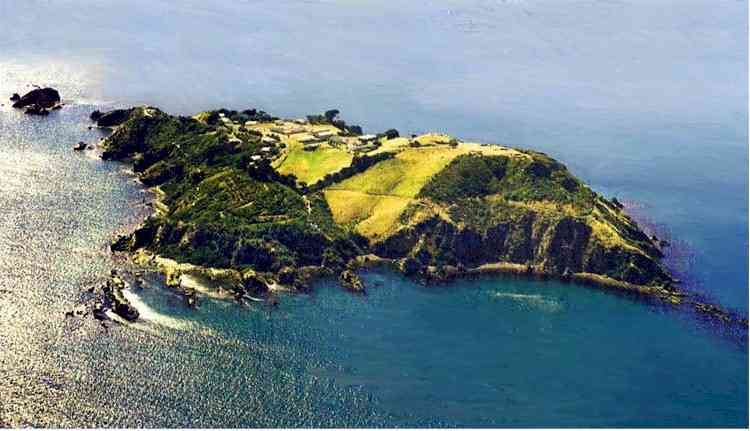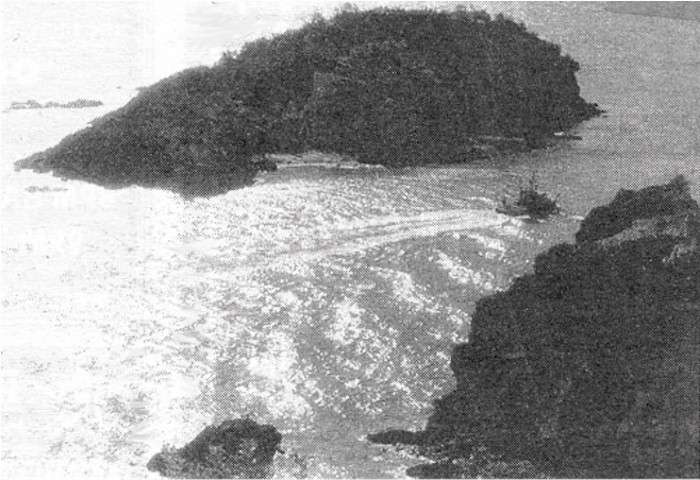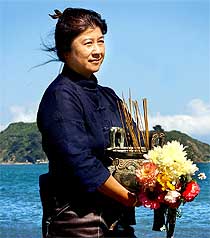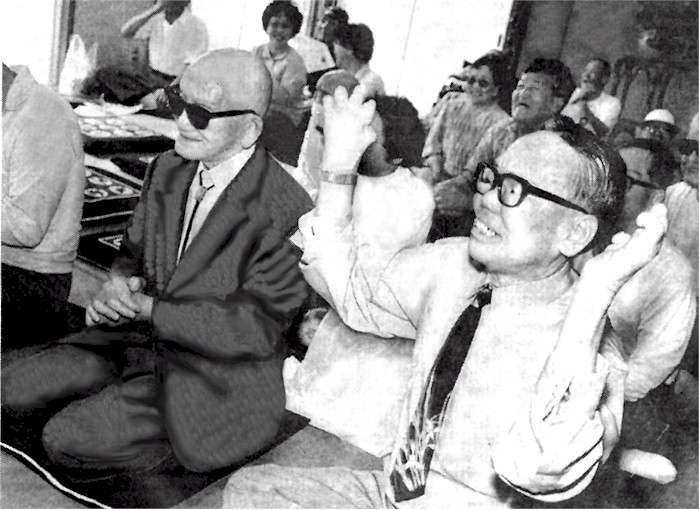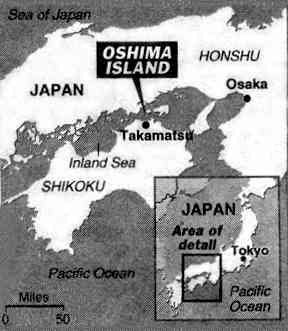Desolation Island
The "Leper" of Somes IslandSolitude vivifies; isolation kills. - Joseph Roux
Mr Kim Lee was banished not to Somes/Matiu Island - but to Mokopuna, the small island in the upper left corner by Kirsten Wong This is the story of a poor unfortunate. A middle-aged Chinese man thought to have leprosy was sent to live on an island in the middle of Wellington Harbour. No, not Matiu or Somes Island but its tiny northwest neighbour, Mokopuna. You can see it driving round the bays. A large cone-shaped rock partly covered in low-lying scrub. There is apparently a cleft in a rocky wall off a sloping beach of gravel. It was in this cleft that Kim Lee, a 56-year-old fruiterer from Newtown lived, and after a short three months, died. Not much is known about his life, except that he was living in Adelaide Road and, at the time of his death in 1904, had been in New Zealand 18 years. According to stories, the Health Department who'd removed him to Mokopuna, employed the local lighthouse keeper to keep him supplied with food. On fine days he'd row out with supplies. In rough weather he sent out rice, hot soup and fruit on a flying fox. Why this extraordinary treatment? The question is partly answered by conditions of the time. At this time there was no known cure for leprosy although some people did seem to have recovered from it. Perhaps even more than now leprosy was viewed with a sort of social horror. Not only was it incurable but it was also physically ugly and contagious (although it could only be caught through prolonged exposure). At the time, the most likely people stricken with it were Maori and a few Chinese. In fact the disease seems to have been pre-colonial. But even by the standards of the century Kim Lee's treatment appears unusual. He was unfortunate enough to live in a time when anti-Chinese feeling was on the rise. Mainly due to the fact that Chinese were moving away from the goldfields and into the cities where they were more visible. A common stereotype was that Chinese were natural carriers of disease. Perhaps this preconditioning made doctors leap to the conclusion of leprosy. Ironically, it now seems Kim Lee may not have suffered from leprosy at all. An examination of records suggest symptoms more consistent with tuberculosis or an auto-immune disease. In any event, Kim Lee appears to be the only person to have been interred on Mokopuna. If you can imagine the desolation you can assume his passing came as a relief. Gwynne Nicol, in Ann Paterson's Stories of York Bat (1983) notes the last remnants of Kim Lee's life were recorded by Elsdon Best when he visited the site a few years later. There were remains of some furniture made of packing cases and a mug on a shelf in the cave.
Mokopuna Island today Source: City Voice, date unnoted - about five years ago
In Memoriam: A City's Banished "Leper"
Paying tribute: Historian Lynette Shum prepares for tomorrow's ceremony by Sue Allen A century ago, suspected leper Kim Lee died alone in a cave on a tiny island in Wellington Harbour. Tomorrow Wellington Chinese Association members will accompany historian Lynette Shum and civic dignitaries at a remembrance ceremony on Somes/Matiu Island. Though little is known about him, it is thought Mr Lee came to New Zealand about 1890 and initially ran a market garden in the Hutt Valley and then a fruit shop in Adelaide Rd, Newtown, till July 1903. But then Mr Lee was diagnosed as having leprosy and banished first to Somes/Matiu Island and then, after complaints from other quarantined residents, to the neighbouring and much smaller Nga Mokopuna, or "Leper" Island. His last 9 months he spent alone in a small cave near the beach, living off meagre supplies that were either rowed out or sent by flying fox. Ms Shum said Mr Lee's exile was a sad story but part of the area's local history. "Can you imagine being sent out there in mid-winter and living in the most howling southerlies? It is just astounding. If he wasn't Chinese I do not think he would have been exiled alone on Nga Mokopuna Island." According to his death certificate, Mr Lee died on 14 March, of heart failure, an enlarged liver and acute renal failure. Modern medical opinion now casts doubt on the original diagnosis and it is thought he may well have died of a chronic disease and malnutrition. "We really don't know much about him. We are not even sure if his name was really Kim Lee or if that was what he called his fruit shop, so people just came to know him by that name," Ms Shum said. But it was quite likely Mr Lee had a family back in China that he was unable to bring over, she said. "Remembering the people who come before you is an important part of our culture." Source: stuff.co.nz 13 March 2004 photo credit Andrew Gorrie/Dominion Post
After 90 Years, Small Gestures of Joy for Lepers
Leprosy patients at a sanatarium on Oshima Island enjoy a karaoke competition. The government has said they will now be officially allowed to travel in Japan, but many fear that social stigmas will keep them isolated. by Calvin Sims Oshima, Japan - On a recent dreary afternoon, as heavy rain drenched this remote island in the Inland Sea, the sounds of unbridled merriment resonated through the scrubbed halls of the Oshima National Sanitarium, where leprosy patients were conducting their annual karaoke contest. One by one the patients, many blinded and disfigured by the disease, were led to a microphone on stage where they belted out traditional enka songs, much to the cheers and delight of their comrades, many of whom had had more than a few beers and glasses of sake. For the 4,500 people with leprosy who survive in Japan, forced to live in isolation for decades long after effective treatments had been found, there has been much to celebrate. In June the government, in a sharp departure from its usual stance, said it would not contest a court ruling that ordered it to pay $15 million to 127 plaintiffs who had challenged the law that kept patients confined to sanitariums on distant mountains and small islands like Oshima. The government also issued a formal apology, its first, for the pain and suffering the patients had endured during their confinement, and it promised to provide all patients, whose average age is 74, with compensation and to help them, if they wanted, to return to society. "We plan to take a trip overseas, maybe go to New York or to Europe," said Yasue Tojyo, 68 and blind, who sang a duet with her husband of 50 years, Takashi Takechi, 70. "I think Japanese people are more sympathetic to us now than in the past. We had a difficult life in here, but we feel fulfilled because we were blessed to have each other." While on this rainy day there was much merrymaking in Oshima, a dazzling island of white sand beaches, rolling green hills and pine forests, residents of this lepers' colony, accessible only by boat, have not forgotten the great sorrow and indignity they have suffered. Men and women told tragic tales of family separation and abandonment, forced abortions and sterilisation, inadequate food and medical care, and hard labour. The Leprosy Prevention Law, enacted in 1907, was enforced for almost 90 years, until it was finally abolished in 1996. Under the law, people found to have leprosy, or Hansen's disease, were rounded up and forced to live in sanitariums. When Yoshio Yakushiji, 71, arrived in Oshima in 1951, he had an eerie feeling that he would never leave what he described as an amazingly beautiful but forbidding place. He was immediately put to work nursing seriously ill lepers. "It was disaster, people were dying all over the place," he said. "There were about 700 patients and only 2 doctors and 10 nurses. Even I was giving injections." Separated from his family and friends, Mr Yakushiji said he nearly died of loneliness until, at 25, he met and married another patient. A few years later, Mr Yakushiji said he suffered the greatest tragedy of his life. His wife, who was 7 months pregnant, was summoned to the medical office and forced to have an abortion. "After the procedure, the nurse handed me a plastic bag with the foetus and placenta, and told me to get rid of it," Mr Yakushiji said. "I dug a hole and buried it. This was our punishment for having a child. Although leprosy is not hereditary, Mr Yakushiji's case is not unusual; many people with leprosy were sterilised, and many women forced to undergo abortions. Lawyers for plaintiffs who sued the government estimated that 3,500 abortions were carried out. Despite popular belief, it is not possible to contract leprosy simply by touching someone who has the disease, which is spread by a bacterium. Once contracted, leprosy attacks the nervous system; untreated, it causes severe deformities. Hands and feet curl inward, hair disappears, the nose collapses and flattens, the lips droop. The face often resembles that of a lion. Many of the deformities are the result of loss of feeling from nerve damage. Patients without a sense of pain or pressure do not notice burns, cuts or bruises, or attend to the pressure sores caused by the disease. Because of the severe social stigma of leprosy, many Japanese families not only committed their relatives to sanitariums, but also deleted their names from social records and had no further contact with them. Some families maintained contact through letters and telephone calls, but kept their leper relatives a closely guarded secret. Although he had occasional contact with his family in Kochi prefecture by telephone, Kazumi Sogano, 74, who arrived in Oshima in 1948, said, his family had made it clear he was not to return home, even when his father became gravely ill eight years ago. "My sister called to tell me he was sick but she never said, 'Brother, please come back and see Father before he dies,'" he said. "It was evident that they didn't want me there." He later learned his father had died, and he has not spoken with his family since. For many of the 229 people with leprosy still living on Oshima, the court ruling ordering compensation and the government's apology are expected to have little or no impact, apart from the symbolism. Many patients are too weak to travel or to make use of the compensation money they have coming. Others said that while the government policy of segregating leprosy patients was a violation of their rights, they had come to accept their lives here because of the cruel discrimination they encountered - and continue to encounter - beyond the island, elsewhere in Japan. "I'm old and handicapped and couldn't leave this place even if I wanted to," said Masao Tane, 78, who is blind and has lost the use of his hands and feet. "I wouldn't say I've had a happy life," he said, "but I've got my television and radio, a few friends and the nurses, who are really sympathetic." Even some relatively healthy patients, fearing discrimination in the outside world, said they had no desire to leave. "The patients here have been isolated and mistreated in the past and that was wrong and very sad," said Dr Shinzo Inoue, the current president of the sanitarium. "Now, as they are living out their last days, I want them to feel like their lives were not a waste of time and that they been fulfilled and meaningful," he said. One patient, Mikio Tomita, 58, who was committed to Oshima when he was 13 but remained in good health because of new treatments, tried many times to live in the outside world. But he always returned to the island because, he said, he faced constant discrimination and lacked the skills and resources to sustain himself. Mr Tomita said he once tried to obtain a driver's license, but when the driving school discovered his home address was Oshima, he was dismissed. He had to hide his past constantly. When he hurt his leg while working in construction, he said, he pretended to feel the doctor pinching his leg, although he really felt nothing. "I was lucky that I had a place to come back to," he said, "a place where I felt at home and normal." Source: The New York Times International Thursday 5 July 2001 photo credit Jonathan Ellis/T-Link
See also:
For articles on white collar and petty crimes, injustice, capital punishment, race, executioners, freedom of the press, cheating, private prisons, punishment, retribution, prison labour, appeals,
instant justice, electronic tags, lepers and second chances click the "Up" button below to take you to the Index for this Prisons section. |
 Animals
Animals Animation
Animation Art of Playing Cards
Art of Playing Cards Drugs
Drugs Education
Education Environment
Environment Flying
Flying History
History Humour
Humour Immigration
Immigration Info/Tech
Info/Tech Intellectual/Entertaining
Intellectual/Entertaining Lifestyles
Lifestyles Men
Men Money/Politics/Law
Money/Politics/Law New Jersey
New Jersey Odds and Oddities
Odds and Oddities Older & Under
Older & Under Photography
Photography Prisons
Prisons Relationships
Relationships Science
Science Social/Cultural
Social/Cultural Terrorism
Terrorism Wellington
Wellington Working
Working Zero Return Investment
Zero Return Investment